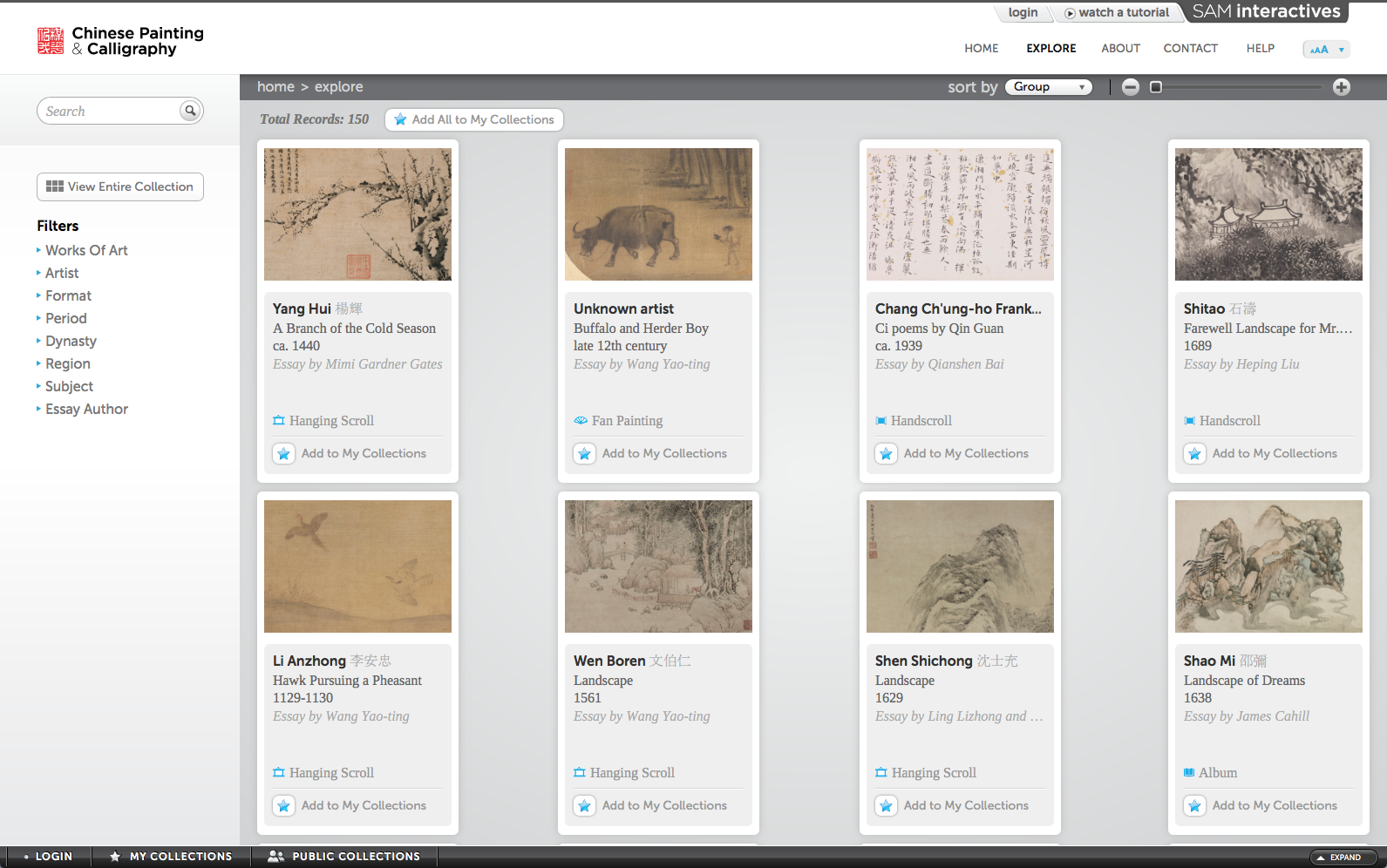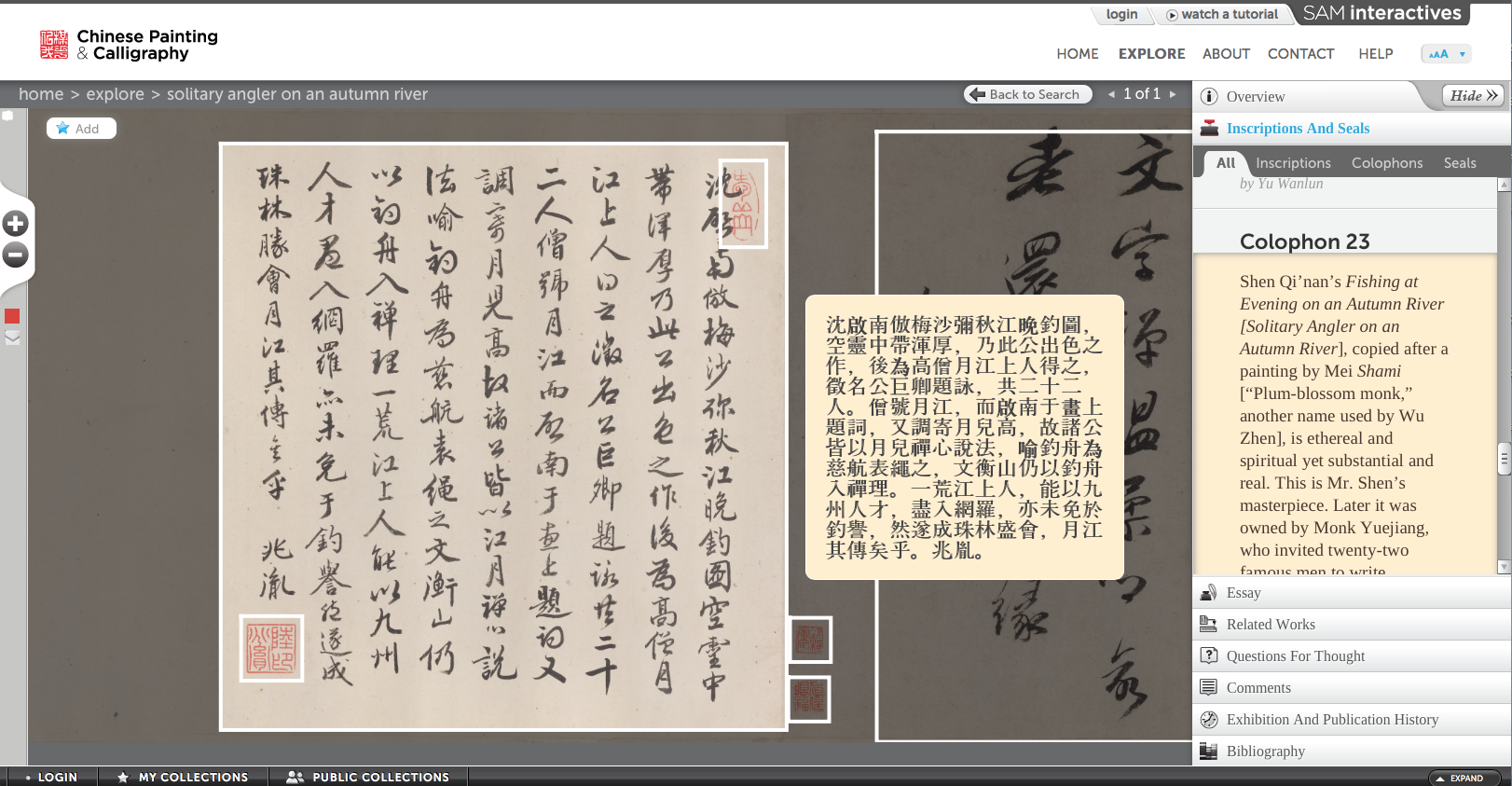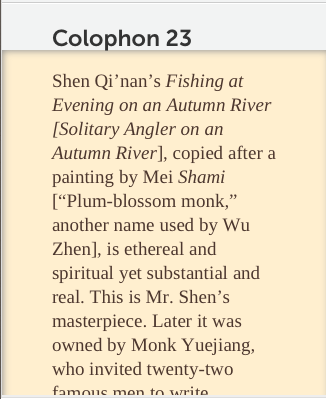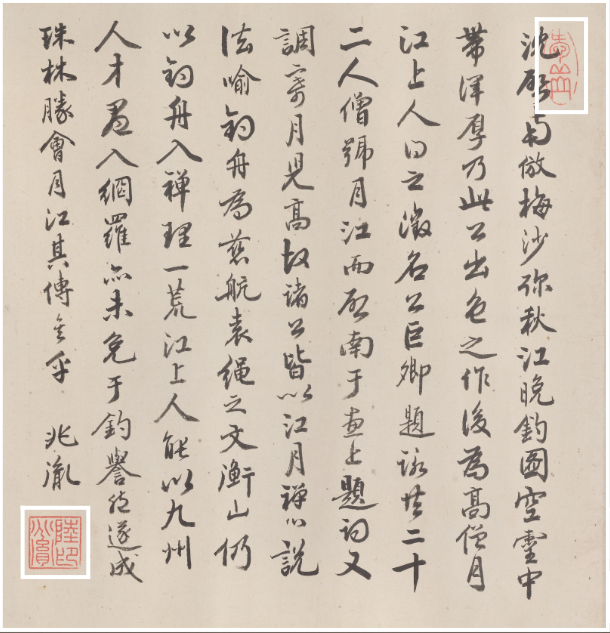Presentation and Interface

Selecting an individual work takes the visitor into a viewer interface that enables close examination of the image and its accreted elements—inscriptions, seals, and colophons, particularly, but in many cases, mountings as well. A large, open palette displaying the image in its entirety extends across the browser window, while to the right, a sidebar, hidden by default, contains the catalog information, scholarly essays, and other curatorial data. One can zoom in on the chosen image through a variety of means; an inset navigator window helps keep track of where you are in the original composition. Depending on the quality of the digitization, the level of available detail is remarkable, in the best cases providing a clear understanding of the brushwork, subtleties of ink washes, and texture of the paper or silk support—even a sense of the restorations and repairs to the artwork.
Clicking on the sidebar from its default hidden position causes it to extend out into or, more precisely, over the main viewing window. Among the sidebar options are tombstone data; inscriptions and seals; a scholarly essay, if one exists for the selected artwork; a list of related works in SAM’s collection; publication and exhibition histories; a bibliography; and two unusual categories for a scholarly catalog: “questions for thought,” generally posed by the curator of Chinese Art at SAM then, Josh Yiu, and a public comments section.
Perhaps the most useful section for researchers, and the one of greatest interest for demonstrating aspects of the site’s interactivity, contains a list of translations and transliterations of each work’s various inscriptions and impressed seals. When opened in the sidebar, the targeted elements become highlighted in the image itself by a series of white boxes. Selecting an ♦inscription or seal in either place takes you to the corresponding item in the other. A floating window in the main viewing panel provides a ♦transcription of the Chinese text, a highly useful feature even for fluent readers of Chinese, as different calligraphic forms are often difficult to decipher, especially when stamped from a carved seal; ♦translations of inscriptions and transcriptions of seals then appear in the sidebar.




The potential utility of this section remains somewhat unfulfilled by incomplete data, however, even for objects in Groups 1 and 2. While a transcription of the seal is of great help, it is equally important to know who the seal belonged to, as owners often employed obscure alternative names in their seals. This information is supplied in some cases, but it is not in many others, even when the accompanying essay or general knowledge makes it clear that the seal owner’s identity is known. For both seals and inscriptions, references to standard seal dictionaries, which were likely consulted during the course of research, would be a great boon, as would citations to major biographical dictionaries; equally important, cases in which the seal owner cannot be identified or such references are unavailable could likewise be noted.[3]
The presentation of the works is thus decidedly object-centric and strongly reflects the visuality and materiality of Chinese painting. This is perhaps most evident when comparing the SAM site to other OSCI interfaces. Most online scholarly catalogs are essentially text-centric, imitating to a greater or lesser degree the format of a printed page. The National Gallery of Art’s seventeenth-century Dutch paintings site might be the most explicit in this regard. As the latest, updated edition of an established print catalog, the layout of the individual digital entries, which features the focus image at the top of a text page, closely imitates that of its analog predecessor.[4] The Art Institute of Chicago, by contrast, strikes something of a balance between text and image while retaining the essential appearance of a print publication. In its catalog of paintings and drawings by Gustave Caillebotte, for instance, which is oriented largely around the artist’s 1877 Paris Street; Rainy Day, the layout remains essentially that of an exhibition catalog, with images set into text.[5] All the artworks discussed in the essay are constantly available through a sidebar, however, while the key image sits in the upper-right corner for quick reference. Furthermore, readers can click directly into an image set within the text at any time, as well as utilize a variety of interactive viewers, such as access to ultraviolet (UV) and X-ray photographs taken during conservation.
SAM’s design places the object literally front and center; the default portal is an object/image viewer whose primary functionality involves navigating and interacting with the image. Text of all types is initially hidden, and even when opened, it remains simply formatted. Thus, the user gains direct access to the work of art in a manner that is ultimately sensitive to the ways in which a viewer of the actual painting or piece of calligraphy would interact with it. Beginning with an overall perspective, one is then able to examine the surface of the image in extraordinary detail. It is not the same as seeing the actual work, to be sure, but it also has its advantages, offering hypernatural levels of visibility that can reveal subtleties in individual strokes that are all but impossible to perceive with the naked eye. For a field of art historical study that still relies heavily on the connoisseurship of brushwork and materials, this is an especially welcome capacity. Indeed, in light of these strengths, I wished for a full-screen mode in order to explore the image without the distraction of other aspects of the navigational interface, a feature that would be of particular benefit when teaching with the site.
The cleanly designed sidebar balances accessibility of information with the primacy of the object. When open, it is narrow enough to create a side-by-side viewing experience. As one reads the catalog essays, this makes it easy to compare details of visual description and argument with the image directly, moving around and zooming in as needed. Although not every essay relies equally on visual argumentation, for those that do—such as Wang Yao-ting’s discussion of Buffalo and Herder Boy, a small fan painting that, based on compositional and stylistic elements, he attributes to the late twelfth century—the capacity to view both the text and an image detail simultaneously is a distinct advantage. It is unfortunate, therefore, that the open sidebar extends over the image, rather than adaptively resizing the viewer window to accommodate both text and the full image on the screen. While this did not pose a problem on a larger desktop screen, on a smaller screen, such as a laptop, certain portions of the image became inaccessible, obscured by the sidebar. Several other technical problems also crop up: surprisingly, the online catalog does not function properly on tablets, which seems a major limitation as such touch-screen devices become more prevalent;[6] URLs for individual works are extraordinarily long and do not always redirect properly when pasted into hyperlinks; and movement back and forth between the slide-table view and specific works eventually leads to problems with navigation, forcing the user back out to the home page.
Throughout the entire catalog, the design also encourages the exploration of text-image relations. The presence of often extensive writing, both directly on the surface of the work of art in the forms of inscriptions and seals and appended to it by way of a frontispiece and/or colophons, is a distinctive element of East Asian painting. These texts may date to the time of the object’s creation or to its later reception and are essential not only to understanding the work itself but also to the process of viewing and experiencing it. Despite the importance of these textual mediations, Chinese paintings are generally cropped for reproduction to present only the image, omitting the often numerous accompanying colophons that evidence its many lives. Inscriptions found directly on the painting are frequently left untranslated and unanalyzed, although they are literally integral to the image field. Seals are rarely reproduced in detail, rendering them entirely illegible. By transcribing and translating all the inscriptions found on works of art in Groups 1 and 2, SAM’s publication allows the contemporary viewer to engage with this information in much the same manner that a viewer of the actual work would have—piece by piece, while looking at it as a whole. Moreover, the importance of these complex intertextual and transtemporal relations is reinforced and expanded on in many of the essays, whether focused on the primary inscription(s), as in Richard Barnhart’s consideration of a short handscroll by Shen Zhou, Solitary Angler on an Autumn River (1492), or on the colophons, as in Zaixin Hong’s treatment of River Landscape after Four Masters (1624), by the late Ming painter Lan Ying. The care and attention given to inscriptions constitute a distinct boon not only to researchers but also to more casual viewers, for whom the textual aspects of Chinese painting are too often inaccessible.
Background image:
Shen Zhou, Solitary Angler on an Autumn River, 1492 (detail of inkwash)
Source: Seattle Art Museum
This page has paths:
This page references:
- Yang Hui, A Branch of the Cold Season, ca. 1440 (detail of repair)
- Shen Zhou, Solitary Angler on an Autumn River, 1492
- Shen Zhou, Solitary Angler on an Autumn River, 1492 (detail of inkwash)
- Shitao, Farewell Landscape for Mr. Wuweng, 1689 (detail of brushwork)
- Wang Yao-ting’s discussion of Buffalo Herder Boy


